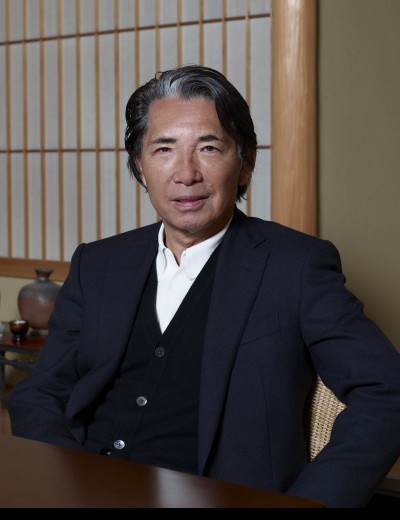the designers
Kenzo Takada was born in 1940 in Kyoto, Japan. Dissatisfied with the literature studies prescribed by his traditional innkeeper parents, he went to Tokyo, where he worked as a house painter and took evening classes in studio art.
In 1958 he joined the predominantly female student body of the Bunka Gakuen School of Fashion. In 1960 he won a Japanese fashion award, the prestigious Soen prize. He began working for the Sanai department store as a designer of girl's clothing, making up to 40 styles every month.
Show Full
In 1964 Kenzo moved to Paris. He took some time to settle in, but eventually he started sketching. The revolutionary new outfits by Courreges were the inspiration for a series of 30 designs he made, 5 of which were accepted by designer Louis Feraud.
Over the next few years, he worked for various departmental stores, the Pisanti textile group and Relations Textiles.
In 1970 Kenzo took over a former antique clothing store in disrepair and painted it himself. Then cutting and sewing a collection of his own designs, he took them round to the fashion magazines. By November he had moved to 28 passages Choiseul and almost immediately his clothes started attracting notice. A boutique in the Galeria Vivienne gave him the chance to introduce his own style to Parisiennes.
He opened his own boutique called "Jungle Jap" selling loose casual clothes, smock tent dresses, and huge striped dungarees with elephant legs. He enlarged armholes and changed the shoulder shape and introduced 100% cotton fabrics. In 1971 Jungle Jap designs were featured in American Vogue as the next development in the Paris boutique scene.
In 1972 Kenzo's show at the Gare d'Orsay was very successful.
In 1975 his first collections were shown in Tokyo. In 1977 he presented his collections in New York.
In 1978 he became known as the "Great White designer" although his designs were very colourful indeed and his styles amazingly diverse.
In 1979 his collection was shown in Zurich for the first time.
In 1990 Kenzo's empire expanded to included menswear, jeans, children's wear and other products.
In October 1999, Kenzo presented his final show, handing over the design to Giles Rosier.
Kenzo had sold his house to the Luxury group LVMH run by Bernard Arnault. However Kenzo Takada himself has no plans to disappear.
At a lunch with the press in May 2002, he outlined his plans. He has started up a label called "Yume" (Japanese for Dream) which will include a series of men and women's apparel and accessories, as well as bed linen with Japanese motifs for La Redoute, Europe's biggest mail order group, owned by Francois Pinault.
In late 2003, it was announced that Antonio Marras, the Italian designer would be the new Artistic Director for Kenzo. Gilles Rosier would be leaving to look after his own label.
